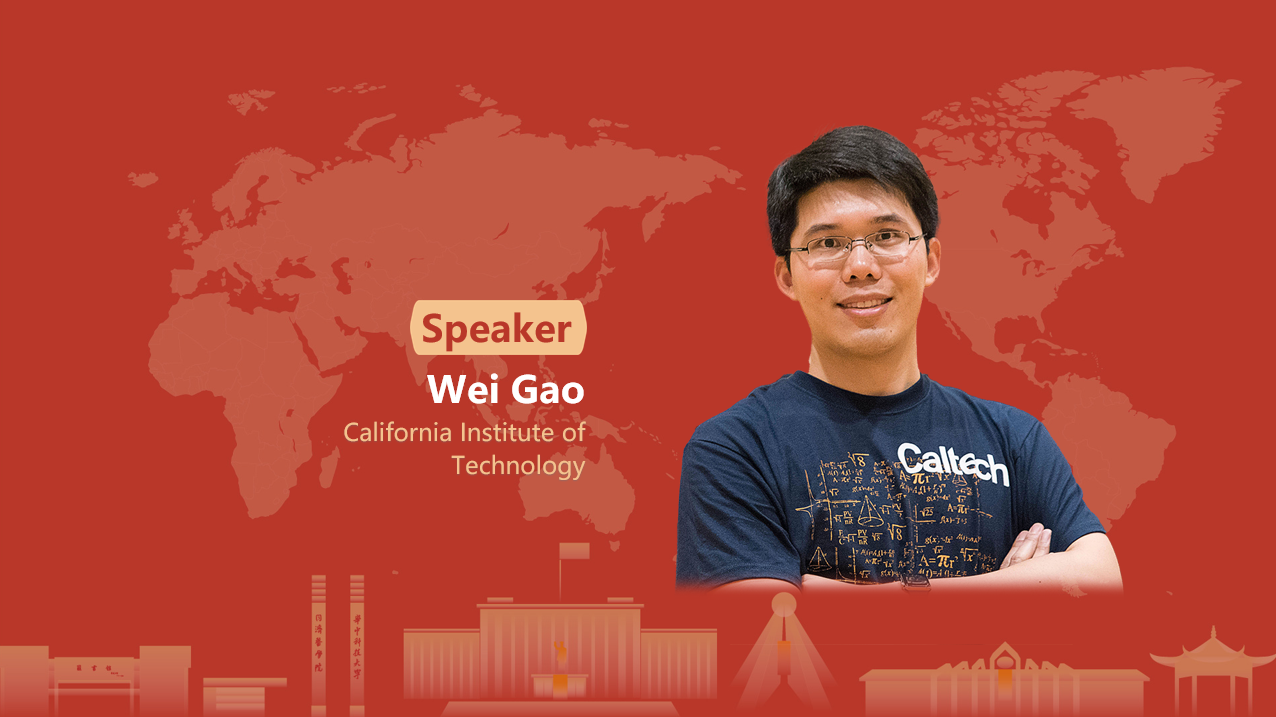博文
iCANX华科70年专题 ┃学术盛宴贺华诞!
||
今晚八点iCANX第118期,是为我的母校华中科技大学七十周年校庆安排的特别节目,分布在五大洲的华科校友将以一场精彩的科技盛宴来庆祝母校七十华诞!欢迎世界各地的朋友一起来参加这场网上大联欢!
Today, welcome all of you from the whole world to join this scientific celebration of my Alma Mater--HUST's 70th anniversary on iCANX Talks!

iCANX Talks Vol. 118 October 7th, 2022
The 70th Anniversary of Huahzong University of Science and Technology
Talk 1
Sulfur electrochemistry and its use in rechargeable batteries
硫电化学与硫基可充电电池
Quanquan Pang 庞全全
Peking University, Beijing, China
E-mail : qqpang@pku.edu.cn
Website : http://pang-eetl-pku.com/
ABSTRACT:Rechargeable batteries are one of the key elements in promoting renewable energy utilization and transportation electrification, which are critical for carbon neutralization. Sulfur is an earth abundant element that is cheap and can offer high redox capacity, and therefore can have great potential to serve as an electrode material for rechargeable batteries. This talk summarizes our research progress on (1) sulfur cathode design strategies for lithium-sulfur battery, (2) high-performance electrolyte designing principles for lithium-sulfur batteries, and (3) establishment of low-cost and highly safe aluminum-sulfur battery based on molten salt electrolytes. The emphasis is on the foundational chemical principles for designing high-performance sulfur batteries, strategies to tune the chemical reactions and the materials approaches to achieve such strategies, and examples of how to establish high-performance sulfur batteries.
可充电电池是支持清洁能源高效利用及交通电气化的重要一环,这于碳中和目标至关重要。硫是一种地壳储量极为丰富的元素,廉价且能提供较高的氧化还原容量,因此是极具前景的电池电极材料。本次报告将总结我们在三个方面的研究(1)锂硫电池的硫正极设计策略,(2)锂硫电池的高性能电解液设计,(3)低成本、高安全铝硫电池的构筑。本报告将重点介绍高性能硫基电池的底层化学设计原则,调节硫电化学反应路径的策略以及实现该策略的材料设计准则,并将举例说明最终如何实现高性能硫基电池。
BIOGRAPHY: Quanquan Pang is an assistant professor in School of Materials Science and Engineering at Peking University. He is among the highly cited researchers certified by Clarivate. He is mainly interested in studying new battery systems, solid state batteries and sulfur batteries for electrochemical energy storage and electric vehicles. He has published over 20 papers in journals including Nature, Nature Energy, Joule, PNAS, Nature Communications and Advanced Materials. He is chairing the National Key R&D programs under the “Electrical Vehicle” Initiative of the Ministry of Science and Technology, China, among other programs.
庞全全是北京大学研究员、助理教授、博士生导师,交叉学科高被引科学家。主要致力于新型储能电池、固态动力电池、硫基电池等化学体系及材料研究。在Nature, Nature Energy, Joule, PNAS,Nature Communications, Advanced Materials等杂志发表SCI论文20余篇,先后主持科技部重点研发计划青年科学家项目、科技部“国际间合作”重点研发计划项目、国家自然科学基金等各类项目。现任EcoMat、Energy Materials Advance、Carbon Energy等杂志青年编。
Talk 2
Skin-Interfaced Autonomous Wearable Biosensors
可穿戴生物传感器
Wei Gao 高伟
California Institute of Technology, Pasadena, CA, USA
E-mail : weigao@caltech.edu
Website : http://www.gao.caltech.edu/
ABSTRACT:The rising research interest in personalized medicine promises to revolutionize traditional medical practices. This presents a tremendous opportunity for developing wearable devices toward predictive analytics and treatment. In this talk, I will introduce our efforts in developing sweat biosensors for non-invasive molecular analysis. Such wearables can autonomously access sweat across activities and continuously measure a broad spectrum of analytes including metabolites, nutrients, hormones, and drugs. Laser-engraving and inkjet printing are used to manufacture these nanomaterials-based biosensors at large scale and low cost. The clinical value of our wearable systems is evaluated through human studies toward nutritional monitoring, disease diagnosis, mental health assessment, and drug personalization. I will also discuss our research progress on energy harvesting from the body fluids and human motion to realize battery-free wireless wearable sensing. These wearable technologies could open the door to a wide range of personalized monitoring, diagnostic, and therapeutic applications.
基于柔性生物电子技术与功能材料器件的深入研究,个性化医疗健康领域得以快速发展,为病情诊断与术后治疗相关的可穿戴电子、柔性生物传感带来了令人振奋的研究契机。在这里,我将介绍我们在研发全集成皮肤界面的柔性生物传感器方面的相关工作,针对汗液中各类生物标志物,包括代谢物、电解质、激素、药物以及其他各类小分子等,进行了非侵入式的连续准确监测。利用激光加工和喷墨打印,我们可以实现大批量低成本的基于各种纳米材料的可穿戴传感器的制备。通过健康人群与病患群体的临床医学研究,在生理信息监测、心理健康、疾病诊断预警与药物输运等方面,对柔性生物传感器进行了可行性评估。在此基础上,我将进一步展示我们在实现自供能去电池化电子皮肤上的最新进展。这些可穿戴汗液生物传感平台的搭建,为实时监测-原位诊断-精准治疗的个性化医疗健康领域带来了全新的发展思路。
BIOGRAPHY:Wei Gao is an Assistant Professor of Medical Engineering, Ronald and JoAnne Willens Scholar in Division of Engineering and Applied Science at the California Institute of Technology. He received his B.S. in Mechanical Engineering at Huazhong University of Science and Technology in 2007 and M.S. in Precision Instrument at Tsinghua University. He received his Ph.D. in Chemical Engineering at University of California, San Diego in 2014. In 2014–2017, he was a postdoctoral fellow in the Department of Electrical Engineering and Computer Sciences at the University of California, Berkeley. He is an Associate Editor of Science Advances, Sensors & Diagnostics, npj Flexible Electronics. He is a recipient of IAMBE Early Career Award, NSF Career Award, ONR Young Investigator Award, Sloan Research Fellowship, IEEE EMBS Early Career Achievement Award, IEEE Sensor Council Technical Achievement Award, World Economic Forum Young Scientist, MIT Technology Review 35 Innovators Under 35, and ACS DIC Young Investigator Award. His research interests include wearable devices, biosensors, flexible electronics, micro/nanorobotics, and nanomedicine.
高伟教授现为加州理工学院医学工程助理教授和Ronald and JoAnne Willens特聘教授,2007年本科毕业于华中科技大学机械学院,2009年于清华大学精密仪器系获得硕士学位,2014年从加州大学圣地亚哥分校获得化学工程博士学位。2014年至2017年期间,在加州大学伯克利分校电子工程与计算科学系开展博士后工作研究。高伟教授现为Science Advances, Sensors & Diagnostics, npj Flexible Electronics 期刊副主编,曾获评美国自然科学基金委杰出青年奖、国际医学与生物工程科学院杰出青年奖,海军研究总署青年科学家奖、斯隆研究奖、IEEE医学与生物学工程学会青年成就奖,IEEE传感器理事会技术成就奖,世界经济论坛青年科学家, 美国化学会青年研究员奖等诸多奖项,入选麻省理工技术评论“35岁以下科技创新35人”全球榜单。他的研究方向包括可穿戴设备、生物传感器、柔性电子、微纳机器人与纳米医学等。
iCANX, Connect the World and Universe
website: www.ican-x.com
https://blog.sciencenet.cn/blog-299-1358307.html
上一篇:科学是真爱:祝贺独眼巨人Sharpless教授再次获得诺贝尔化学奖!
下一篇:张海霞│百岁奶奶的诺奖礼物


